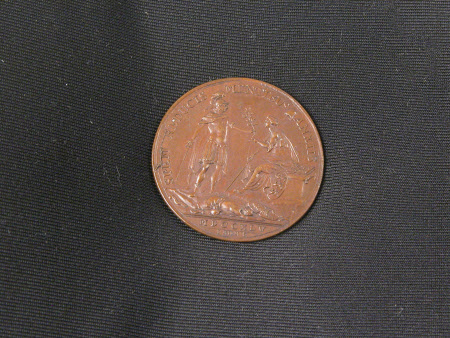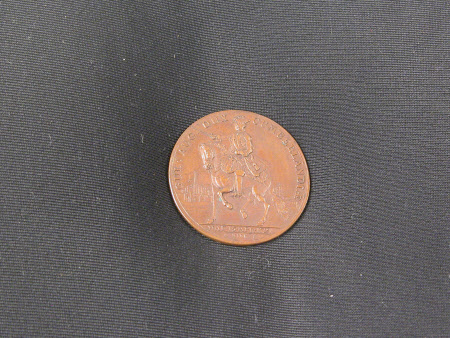The Rebels Repulsed
A. Kirk (d. c.1761)
Category
Coins and medals
Date
1745
Materials
Copper
Measurements
346 mm (Diameter)
Place of origin
London
Order this imageCollection
Osterley Park and House, London
NT 773308
Summary
Copper, the Rebels Repulsed, by A. Kirk (fl. 1745, died c. 1761) and John Kirk (1724-76), struck London, Great Britain, 1745. A copper medal by John Kirk (1724-76) and A. Kirk (fl. 1745, died c. 1761) commemorating the recapture of the city and castle of Carlisle by Hanoverian forces, under the command of Prince William, Duke of Cumberland (1721-65) in December 1745, and the retreat of the Jacobite rebels into Scotland. On the obverse, signed by A. Kirk, is the equestrian portrait of the Duke of Cumberland with a sword in his outstretched right hand, and on the horizon the city and castle of Carlisle. The image of the fortified town of Carlisle is taken from an engraved image by Buck, published in 1739 and revised in 1745. The Latin legend reads ‘William Augustus Duke of Cumberland’ and, in the exergue, ‘Born 15 April 1721’. The reverse is signed by John Kirk and shows the allegorical seated figure of Anglia, who holds a spear surmounted by the cap of Liberty, and has a bible open by her side. She is being proffered an olive branch by the Duke, who stands before her, dressed in all’antica armour. At his feet is the prostrate figure of a rebel, with a yoke, a broken sword and a papal shield. The legend translates as ‘Hope of return to anxious minds’ whilst the date, 1745, is in the exergue.
Full description
After his arrival in Scotland in July 1745, Prince Charles Edward Stuart, known as the Young Pretender or, more romantically, Bonnie Prince Charlie, gathered support in the Highlands before marching on and capturing Edinburgh in September. Prince James (‘The Old Pretender’, 1688-1766) was proclaimed King James VIII of Scotland in the capital, whilst his son the Young Pretender began to prepare for the invasion of England. In early November the Jacobite forces advanced into northern England, capturing Carlisle by mid November. Prince Charles continued to push southwards, as far as Derby. However, the Hanoverians responded by recalling from service in France the Duke of Cumberland, brother of King George II. He was placed at the head of a well-equipped army which marched towards the Young Pretender’s forces, supported by a separate force under the command of General Wade. The Duke’s easy retaking of Carlisle in late December 1745 was regarded as a pivotal point in the defeat of the rebels and was celebrated through a number of propagandistic medals, which played on the enormous popularity in England of the Duke, who returned to London after the capture of Carlisle, before rejoining his armies to continue the harrying of the increasingly disunited and desperate Jacobite forces, who met their final conclusive defeat at Culloden Moor on 16 April 1746. This medal is one of the best-known of the series of medals celebrating the repulsing of the rebels and glorifying the prowess of the Duke. The positive contemporary treatment of the Duke contrasts with his more negative reputation until the present day as ‘Butcher Cumberland’, referring to his exceptionally harsh treatment of rebels and their families, during and following Culloden. The reverse of the medal represents a Hanoverian allegorical interpretation of their struggle against the Jacobites, with the Protestant ‘English’ cause associated with good religion, liberty and peace, contrasted with the Jacobite rebel cause, here shown as synonymous with oppression, violence and Popery. The Kirk family were a ‘toy maker’s’ establishment situated in St. Paul’s Churchyard, London. They made medals in a variety of materials but to a generally high standard, aiming their products at middle-class customers. The A. Kirk who signed the obverse was probably a brother of the better-known John, who is known to have studied under the engraver and medallist James Anthony Dassier. Jeremy Warren 2019
Provenance
Given to the National Trust in 1993 by George Child Villiers, 9th Earl of Jersey (1910-1998).
Marks and inscriptions
Obverse, legend: GUL : AUG : DUX CUMBERLANDIAE Obverse, exergue: NAT. 15. APR. 1721/A. KIRK F Reverse, legend: SPEM REDUCIS MENTIBUS ANXIIS Reverse, on book by Anglia: BIBLIA SACRA Reverse, exergue: MDCCXLV/I. KIRK F
Makers and roles
A. Kirk (d. c.1761), medallist John Kirk (c.1724 - c.1778), medallist
References
Cochran-Patrick 1884: Robert William Cochran-Patrick, Medals of Scotland from the earliest period to the present time, Edinburgh 1884, p. 86, no. 9, Pl. XVI, no. 4 (obverse only). Hawkins, Franks and Grueber 1885: Edward Hawkins, Augustus W. Franks and Herbert A. Grueber (eds.), Medallic Illustrations of the History of Great Britain and Ireland to the death of George II, 2 vols., London 1885, vol. II, pp. 606-07, no. 264. Woolf 1988: Noel Woolf, The Medallic Record of the Jacobite Movement, London 1988, p. 98, no. 53:1. Mitchiner 1988-2007: Michael Mitchiner, Jetons, Medalets and Tokens, 4 vols., London 1988-2007, vol. III (British Isles circa 1588 to 1830), 1998, p. 1721, no. 3c. (5026).

